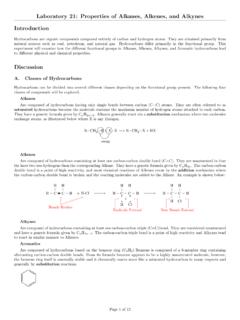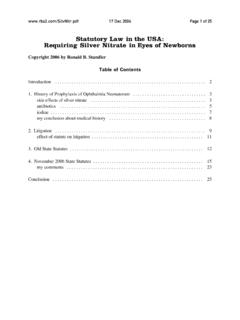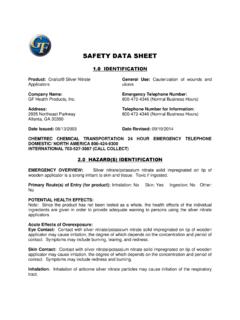Transcription of Laboratory 4: Determining the Identity of an …
1 Laboratory 4: Determining the Identity of an Unknown Compound Introduction You accidentally forgot to label a bottle of clear liquid, how can you determine its contents? Or perhaps you find a mysterious bottle on the shelf, how can you identify it? We will explore using the chemical properties of compounds to identify an unknown liquid based on its characteristic chemical reactions. We will become familiar with the signs and observations that a chemical reaction has occured. We will also explore several logic concepts including inclusive, exclusive, and indeterminate results. Discussion In previous labs we have used physical characteristics to determine the Identity of an unknown compound. We can do the same thing by probing an unknown compounds chemical characteristics. In this you will be given aqueous samples of sodium chloride ( NaCl ),sodium iodide ( NaI ), sodium hydrogen carbonate ( NaHCO3 ), sodium carbonate ( Na2 CO3 ), sodium hydrogen phosphate ( Na2 HPO4 ), and sodium sulfate ( Na2 SO4 ).
2 You will test these compounds for characteristic reactions with nitric acid ( HNO3 ), barium nitrate ( Ba(NO3 )2 ), silver nitrate ( AgNO3 ), nitric acid ( HNO3 ), ammonium hydroxide ( NH4 OH ), and an acid-base indicator called thymol blue. You will also be given an unknown sample that will be identical to one of the solid samples. After testing the known compounds, you will subject your unknown substance to those same tests. You will be able to determine the unknown sample's Identity by matching its characteristic reactions with those of the known samples. This experiment emphasizes the importance of accurate observations, properly recording them, and the use of deductive logic to draw conclusions from those observations. If you make accurate observations and record them faithfully, you will be able to identify the unknown compound without difficulty. Accurate observations are the only criterion for success. No prior knowledge of the chemistry that you will observe is necessary or assumed.
3 Signs of a Chemical Reaction We will be observing the characteristic chemical properties of compounds through a series of tests with different reagents and observing if a chemical reaction occurs or not, and if so what specifically occurs. There are several signs that a chemical reaction has occurred. These signs are: 1. Color changes, that are not the result of simple dilution. 2. Evolution of a gas forming many bubbles rapidly. 3. Formation of a precipitate, normally a solid which will settle to the bottom of a test tube, but occasionally a finely divided precipitate that does not settle and often appears as only a milky color. 4. Disappearance of a precipitate. 5. Endothermic or Exothermic reactions (creation of heat or cold). There are several cases where it is difficult to tell if a chemical reaction occurred. When dissolving a solid or precipitate, only a portion is dissolved, thus leaving some behind, and fooling a student into incorrectly reporting that no reaction occurred, or that a precipitate formed.
4 This can be avoided by realizing that the original compounds are generally crystalline, and will sit at the bottom of a test tube (or settle out quickly), while a precipitate will have a milky appearance, and tend to spread evenly throughout the solution. A less common mistake is mistaking a lightening in color of a solution as a color change when it is simply due to the dilution of the original color. In general color changes will be fairly drastic, red to blue, green to yellow, not blue to light blue. Another common mistake is observing one or two bubbles due to the mixing or stirring of a liquid solution and reporting it as the formation of a gas. Generally the formation of a gas will be very rapid and vigorous, and should be very noticeable. Standard nomenclature for these observations are shown below in Table 1. The exact nomenclature will vary from book to book, and person to person, but these general rules work well. Page 1 of 10. Laboratory 4: Determining the Identity of an Unknown Compound Observation Nomenclature Example Color change color 1 color 2 red blue Gas formation (g) - descriptor (g) - vigorous Formation of a precipitate descriptor - ppt milky white ppt Disappearance of a precipitate ppt dissolves (descriptor) ppt dissolves (2 drops).
5 Exothermic or Endothermic hot/cold or NR hot No reaction NR or x NR or x Table 1: Typical nomenclature used to describe chemical properties. Inclusive and Exclusive Reasoning When making observations and applying them to Determining the Identity of an unknown that may be a single chemical or a mixture of two or more chemicals, it is often necessary to determine whether a test provides an inclusive, exclusive or indeterminate answer. A test would be considered inclusive if the result indicated that a specific substance must be in the unknown mixture, an exclusive test would indicate that a specific substance must be excluded from the mixture. A third situation does exist which is when a test is indeterminate about whether a substance is in the mixture, neither including it or excluding it. Consider the following set of results in Table 6. Compound Reagent 1 Reagent 2 Reagent 3. A ppt occurs no reaction hot B ppt occurs ppt occurs hot C no reaction ppt occurs (g) - No temp change D (g) no reaction hot Unknown ppt occurs ppt occurs hot Table 2: Reaction Data for Several Compounds Assuming you have an unknown mixture of two of the compounds A, B, C, and D and mixed the unknown with each of the Reagents 1-3.
6 Table 3 summarize the results. The results from reagent 1 are inclusive in that that you must have either compound A and/or B in your mixture, excludes compound D becuase no gas is observed and is indeterminate for compound C because it could be masked by A or B. The results from reagent 2 are inclusive in that you must have either B and/or C, but you can't exclude A or D being present because their presence could be masked by B or C. Reagent 3 is inclusive for A, B, and D but excludes C since no gas was formed. Combining our results we can state that our unknown can not contain C. and D and therefore must be a mixture of compounds A and B. Reagent Inclusive Exclusive Indeterminate Reagent 1 A and/or B D C. Reagent 2 B and/or C none A and D. Reagent 3 A, B, D C none Table 3: Inclusive, Exclusive, and Indeterminate results Page 2 of 10. Laboratory 4: Determining the Identity of an Unknown Compound Procedure In this experiment you will be observing the reactions of 6 known compounds and one unknown compound with different reagents.
7 Record all observations you make in the appropriate place. The tests are separated into 4 different tests (Parts 1-4), you may perform the tests in any order. You may work in pairs to perform Parts 1-4, but each individual should obtain a different unknown to identify. Read the entire procedure before beginning the experiment. Part 1 - Testing for Gas Evolution 1. Label 6 clean test tubes with the Identity of each known compound and place 1 ml (about 20 drops) of each known liquid in each using a spatula. 2. Add 5 drops of 3 M (concentrated) Nitric Acid to each test tube and record your observations. Be very careful with the Nitric Acid, it will eat holes in your clothes! 3. Discard the contents of the test tube in the sink and rinse with distilled water. You may use these same test tubes for the rest of the experiment. Part 2 - Barium Nitrate and Nitric Acid Test 1. Label 6 clean test tubes with the Identity of each known compound 2. Using the known solutions available in the Laboratory place 1 mL (20 drops) of each known compound into your labeled test tubes.
8 3. Add 3 drops of ammonia to each test tube and stir with a clean stirring rod. Remove the stirring rod and touch a drop of each solution to a strip of red litmus paper. The paper should turn from red to blue, if it does not add drops of ammonia to the solution until it does. Do not record any results for this step, we are simply preparing the solution for the next step. 4. Add 5 drops of the Barium Nitrate solution to each test tube. Mix each tube gently (as demonstrated in class) to obtain a homogeneous solution. Record your observations in the column labeled Barium Nitrate. 5. The next step only applys to those test tubes that contained precipitates. Add 5 drops of 6 M Nitric Acid to each of these test tubes. Using a clean stirring rod, test each solution with a strip of blue litmus paper. If the paper does not turn from blue to pink, continue adding drops until it does. Examine each test tube carefully and note which of the precipitates has dissolved. Record your observations in the Barium Nitrate + Nitric Acid column.
9 6. Discard the solutions in the test tubes in the Waste Container labeled Barium or Ba+2 Waste which can be found in the hood. 7. Wash your test tubes and rinse them with distilled water. Part 3 - Silver Nitrate and Nitric Acid Test 1. Label 6 clean test tubes with the Identity of each known compound 2. Using the known solutions available in the Laboratory place 1 mL (20 drops) of each known compound into your labeled test tubes. 3. Add 5 drops of the Silver Nitrate solution to each test tube. Mix each tube gently (as demonstrated in class) to obtain a homogeneous solution. Record your observations in the column labeled Silver Nitrate. 4. The next step only apply to those test tubes that contained precipitates. Add 5-10 drops of 6 M Nitric Acid to each of these test tubes. Using a clean stirring rod, test each solution with a strip of blue litmus paper. If the paper does not turn from blue to pink, continue adding drops until it does. Examine each test tube carefully and note which of the precipitates has dissolved.
10 Record your observations in the Silver Nitrate + Nitric Acid column. Page 3 of 10. Laboratory 4: Determining the Identity of an Unknown Compound 5. Discard the solutions in the test tubes in the Waste Container labeled Silver or Ag+ Waste which can be found in the hood. 6. Wash your test tubes and rinse them with distilled water. Part 4 - Thymol Blue test Thymol blue is a strong dying agent, it will stain clothing and fingers so be careful with it. 1. Label 6 clean test tubes with the Identity of each known compound 2. Using the known solutions available in the Laboratory place 1 mL (20 drops) of each known compound into your labeled test tubes. 3. Add 5 drops of thymol blue to each test tube. 4. Dilute each solution by adding mL of water. 5. Record your observations. 6. Carefully add 1 drop of 6 M Nitric Acid to each test tube. 7. Stir each tube gently and record your observations in the column labeled Thymol Blue. 8. Discard the solutions in the test tubes in the sink.






